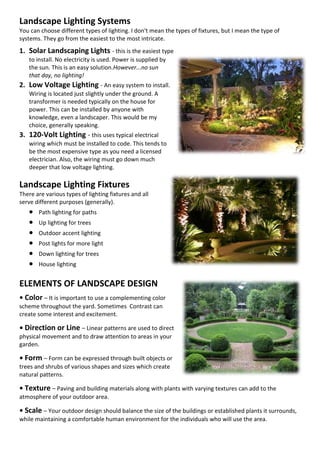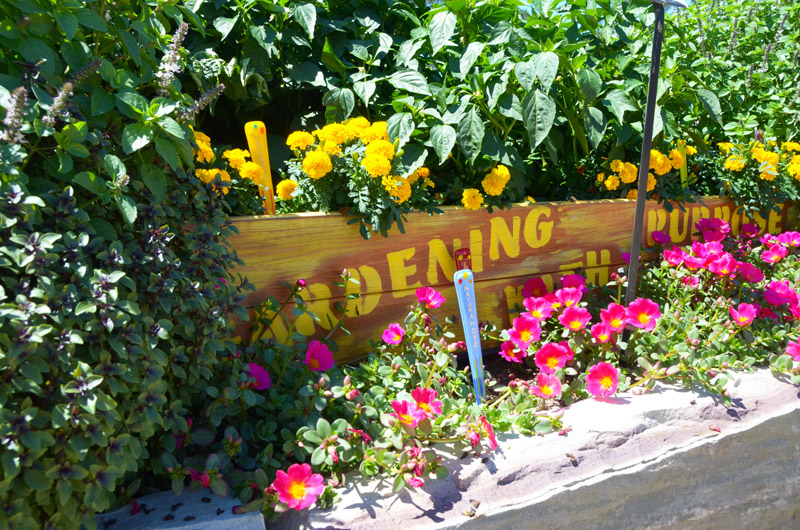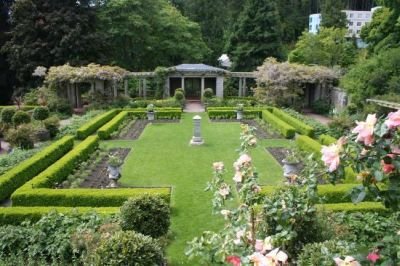Get This Report about Hilton Head Landscapes
Table of ContentsThe Best Strategy To Use For Hilton Head LandscapesOur Hilton Head Landscapes IdeasThe Best Guide To Hilton Head LandscapesExcitement About Hilton Head Landscapes4 Easy Facts About Hilton Head Landscapes ShownThings about Hilton Head LandscapesHilton Head Landscapes Things To Know Before You Get This
Line produces all forms and patterns and can be used in a variety of means in the landscape. Line in the landscape is produced by the edge between 2 products, the rundown or silhouette of a form, or a lengthy linear function. Lines are a powerful device for the designer because they can be made use of to produce an unlimited selection of shapes and kinds, and they control activity of the eye and the body.

Lines in the landscape. The homes of lines figure out just how people respond to the landscape, both psychologically and physically.
More About Hilton Head Landscapes
Straight lines are most typically discovered in hardscape sides and product. Curved lines produce an informal, natural, unwinded character that is associated much more with nature and asymmetrical balance. Curved lines move the eye at a slower speed and include secret to the room by creating covert views. Vertical lines relocate the eye up, making a room feel bigger.
Upright lines in the landscape include tall, narrow plant material, such as trees, or high frameworks, such as an arbor or a bird residence on a pole. Straight lines move the eye along the ground plane and can make an area feel bigger. Low lines are more controlled and create a sensation of remainder or repose.
Indicators on Hilton Head Landscapes You Should Know
Low lines are produced by low garden wall surfaces, sidewalks, and short bushes. Lines are made use of to draw kinds on a plan. In strategy view, they specify plant beds and hardscape areas. Lines are additionally produced by the upright forms of constructed features and plant product. There are three main line kinds that create type in the landscape: bedlines, hardscape lines, and plant lines.
Bedlines attach plant material to your house and hardscape because the eye adheres to the line, moving the stare through the landscape. Hardscape lines are produced by the edge of the hardscape, which defines the constructed structure. Line can additionally be produced by long and slim materials, such as a fence or wall surface.
The Only Guide to Hilton Head Landscapes
Form is discovered in both hardscape and plants, and it is typically the dominant aesthetic element that spatially organizes the landscape and often figures out the style of the yard. The form of structures, plant beds, and garden ornaments also establishes the total kind style of the garden. Formal, geometric forms include circles, squares, and polygons.
Plants create kind in the yard with their details or silhouettes, yet type can also be defined by a void or adverse area between plants - Landscapers near me (https://issuu.com/h1tnhdlndscps). Circles can be full circles, or they can be divided right into fifty percent circles or circle sections and combined with lines to develop arcs and tangents
Little Known Facts About Hilton Head Landscapes.
Circles can likewise be stretched into ovals and ellipses for even more selection and next page interest. Circles are a strong design form due to the fact that the eye is always attracted to the facility, which can be used to stress a centerpiece or link other types. Number 2. Circular types in hardscape and yard panels.
The square kind can also be fractional and previously owned continuously to develop a grid pattern. Unlike circles, squares are stronger on the edges, which can be lined up or overlapped to produce one-of-a-kind patterns and more complicated kinds. Polygons are many-sided forms with straight edges. Triangles, as an example, are three-sided polygons.
Twisting lines commonly resemble the all-natural program of rivers or streams and can be defined as smooth lines with deeply bent wavinesses. Twisting lines (Figure 3) function well for paths, plant bedlines, and completely dry stream beds. Twisting lines can include passion and enigma to a yard by leading visitors around edges to uncover brand-new sights and rooms.
The Basic Principles Of Hilton Head Landscapes

Number 5. Fragmented sides: stepping stones in pathway. Kind is one of the most enduring quality of a plant (landscapers in bluffton sc). https://www.storeboard.com/hiltonheadlandscapes. Usual plant forms are well established and standardized, as kind is one of the most consistent and recognizable characteristic of plants. Kind can likewise be created via the massing of plants, where the general mass creates a various type than an individual plant.
A highly contrasting kind should be used with careone or 2 work well as a centerpiece, but a lot of wreak havoc. All-natural plant types, as opposed to over-trimmed forms, need to establish the mass of the structure. The significance of overall type is basically reliant on the seeing perspectivethe kind of a tree can show up quite various to an individual standing under the canopy versus seeing the tree from a range in an open field.
Hilton Head Landscapes - Truths
Plant kinds likewise create and define the gap or open rooms in between the plants, developing either convex or concave types in the spaces. High-arching tree branches usually produce a concave open area under the branches, and a round canopy with low branches fills up the area to produce a convex type in the open area under the tree.
